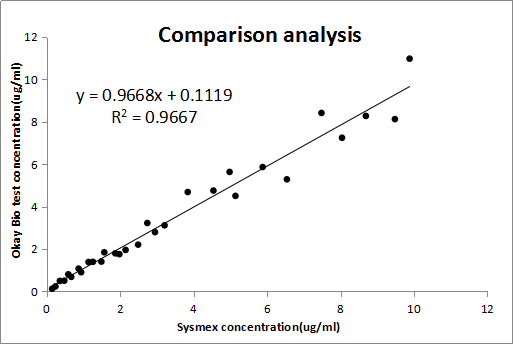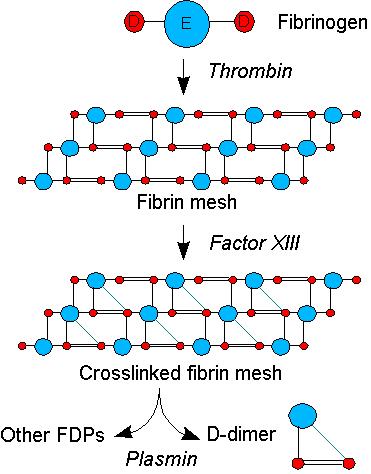D-dimer
| Description |
Mouse monoclonal antibody |
| Catalog number |
K65f1 |
K86d3 |
| Applications |
Detection |
Capture |
| Platforms |
Immunofluorescence and Chemiluminescence |
| Buffer |
1 x PBS |
| Purity |
Purity>98%,purified by Protein A/G chromatography |
| Storage instructions |
Upon delivery aliquot and store at -80°C. Avoid freeze / thaw cycles. |

Antibody Product Information
Antibody Evaluation (Immunofluorescence-based)
Immunofluorescence-Based test strip was prepared with K65f1-K66h2 matched antibody pairs (30 Sysmex calibrators, Concentration: 0.1-10 ug/ml, R2 > 96%)

Fig. 1 Coincidence rate of Immunofluorescence-based test strip (K65f1-K66h2)
Accuracy
The quality control samples with concentration of 0.5 ug/ml-1.5 ug/ml and 4.5 ug/ml-5.5 ug/ml respectively were required to repeat test three times. B= (M-T) / T×100% (B: Relative Standard Deviation, M: Average, T: Concentration)
|
Sample(μg/ml) |
Test 1 |
Test 2 |
Test 3 |
Average(μg/ml) |
RSD |
Standard |
| Batch 1 |
1.15 |
1.08 |
1.14 |
0.98 |
1.07 |
-7.25% |
±15% |
| 5.04 |
5.47 |
5.28 |
5.09 |
5.28 |
4.76% |
| Batch 2 |
1.15 |
1.15 |
1.23 |
1.17 |
1.18 |
2.90% |
| 5.04 |
5.09 |
4.86 |
4.89 |
4.95 |
-1.85% |
| Batch 3 |
1.15 |
1.08 |
1.24 |
1.20 |
1.17 |
2.03% |
| 5.04 |
4.73 |
4.69 |
4.80 |
4.74 |
-5.95% |
Repeatability
The quality control samples with concentration of 0.5 ug/ml-1.5 ug/ml and 4.5 ug/ml-5.5 ug/ml respectively were required to repeat test over 10 times. CV= (S /

) ×100% (CV < 15% as indicated in the following table)
|
Low Value
(1.15μg/ml) |
High Value
(5.04μg/ml) |
| Test 1 |
1.27 |
5.07 |
| Test 2 |
1.11 |
5.11 |
| Test 3 |
1.08 |
4.88 |
| Test 4 |
0.98 |
4.74 |
| Test 5 |
1.27 |
4.61 |
| Test 6 |
1.04 |
5.33 |
| Test 7 |
1.14 |
5.17 |
| Test 8 |
0.95 |
5.09 |
| Test 9 |
1.11 |
5.14 |
| Test 10 |
1.07 |
4.77 |
| Average(μg/ml) |
1.10 |
4.99 |
| SD |
0.11 |
0.23 |
| CV |
9.63% |
4.57% |
| Standard |
±15% |


Description
D-dimers are specific degradation products of cross-linked fibrin. It has emerged as a promising diagnostic marker with high sensitivity for exclusion of acute aortic dissection.
Higher levels occur in situation in which there is excess clotting followed by fibrinolysis. While a negative result practically rules out thrombosis, a positive result can indicate thrombosis but does not rule out other potential causes. It is used to exclude thromboembolic disease where the probability is low. In addition, it is used in the qualification of the blood disorder disseminated intravascular coagulation (DIC).

Related Products
![]() Datasheet)
Datasheet) Fig. 1 Coincidence rate of Immunofluorescence-based test strip (K65f1-K66h2)
Fig. 1 Coincidence rate of Immunofluorescence-based test strip (K65f1-K66h2) ) ×100% (CV < 15% as indicated in the following table)
) ×100% (CV < 15% as indicated in the following table)
